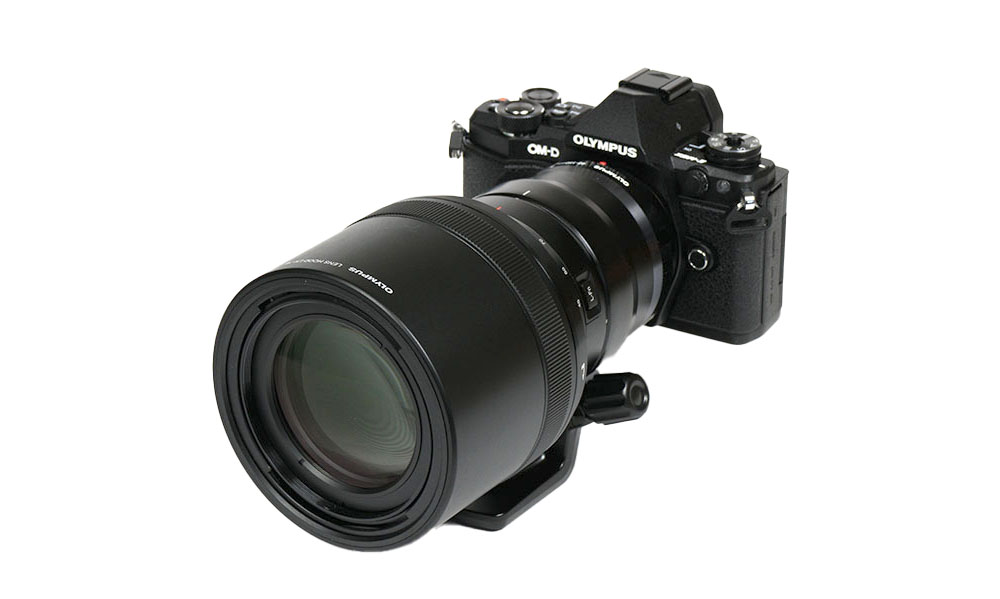
At the time Olympus started the “classic” Four-Thirds system, they focused on professional grade lenses. However, this didn’t work out for a couple of reasons mostly on the camera side (although I was thrilled by the E-1). After moving to Micro-Four-Thirds, both Olympus as well as Panasonic stayed short of this segment for quite some time and preferred to concentrate on amateur products. While this strategy succeeded in terms of market share, it also represented a problem. The amateur segment is a low margin game. However, now that a healthy customer base has been established, it seems as if the gang is getting more bold again. Panasonic started to release some expensive Leica lenses and Olympus is busy expanding their M.Zuiko Pro lineup. As of the time of this review, it contains 3 zoom lenses with 2 primes in the pipeline. In this review we’ll cover the tele zoom lens – the Olympus M.Zuiko Digital ED 40-150mm f/2.8 Pro.
When playing the usual “equivalence” game again, the specs translates to a “80-300mm f/5.6” full format lens. Some readers may shout out in agony that a f/2.8 lens remains an f/2.8 lens. That’s true, of course, but in terms of depth-of-field – thus the creative potential – the 2x crop factor has to be applied as well (roughly). In this framework, the lens compares to something like a Canon EF 70-300mm f/4.5-5.6 USM L IS. The Olympus lens is more light-weight and compact just as promised by the MFT marketeers but about as expensive despite the smaller image circle. Mirrorless doesn’t mean more affordable once more unfortunately.
The build quality of the M.Zuiko is certainly up the with the big boys as well. The lens body is made of metal, everything is tightly assembled, weather sealed and the control rings operate smoothly. Olympus even implemented a tripod mount for a better balance although it isn’t perfectly implemented. The balance point is way too far towards the rear – if you place the camera-lens combo on a table it’ll actually tip over towards the camera (we used trickery in the product shot to avoid this). A really cool feature is the design of the lens hood. You mount it like any other hood but there is no need to reverse it for transport – instead you just slide it back. Kudos, Olympus!

The M.Zuiko ED 40-150mm f/2.8 Pro is the first lens to feature a Dual VCM (Voice Coil Motor) AF system. Rather than using just one
motor it uses two in order to move one “floating” lens group each independently. This is supposed to improve both AF speed as well as close focus performance. We tend to concur although it still stays short of the best DSLR setups. Manual focusing works “by wire” thus the AF motor is actuated via the focus ring. This system works just fine.
| Specifications | |
|---|---|
| Equiv. focal length | “80-300mm” (full format equivalent) |
| Equiv. aperture | f/5.6 (full format equivalent in terms of depth-of-field) |
| Optical construction | 16 elements in 10 groups inc. 1x aspherical-ED, 2x aspherical, 1x SED, 3x ED and 1x HD element |
| Number of aperture blades | 9 (circular) |
| min. focus distance | 0.7m (1:2.4) |
| Dimensions (L x W) | 79.4×160mm |
| Weight | 760g |
| Filter size | 72mm |
| Hood | Barrel-shaped, telescope-style, bayonet mount, included |
| Other features | Dustproof and splashproof, ZERO coating, Dual VCM |
Distortion
The Micro-Four-Third system uses an automatic distortion-correction under the hood thus from a user perspective, this is nothing to worry about. The measured distortions are all south of 0.1%!

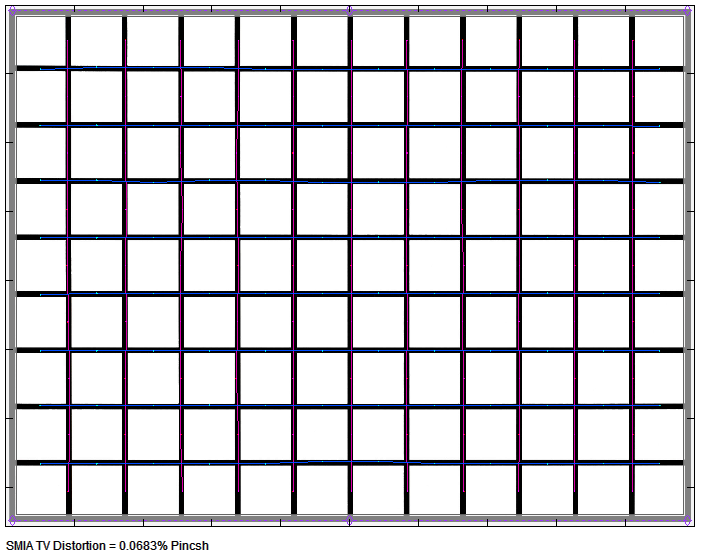
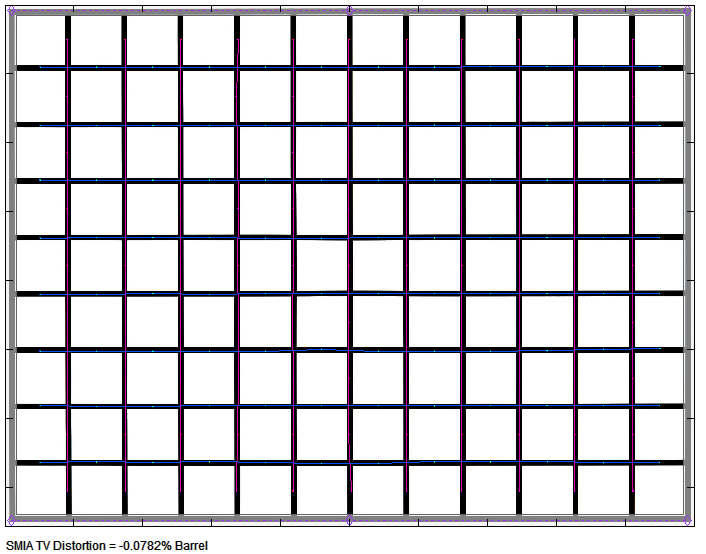
While most RAW converter as well as the camera (JPEGs) don’t give you a choice, a few still do (e.g Capture One) thus it is actually possible to verify the original characteristic of the lens. With disabled auto-correction, the Olympus lens shows a 2% barrel distortion at 40mm although nothing worth to mention beyond.

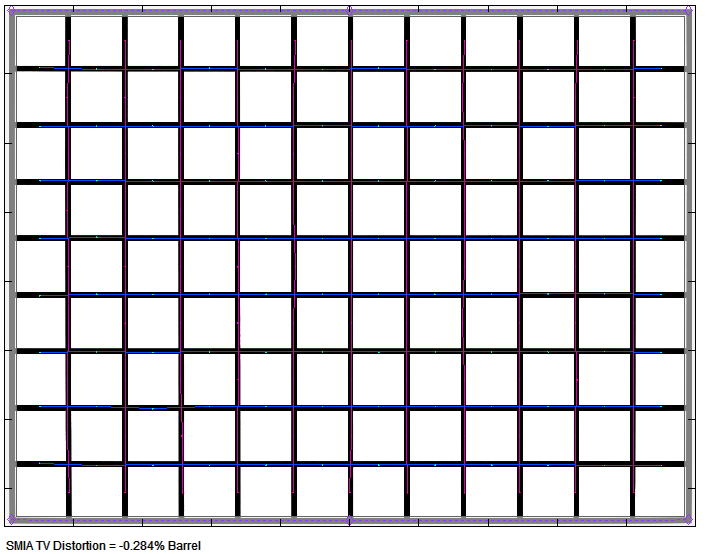
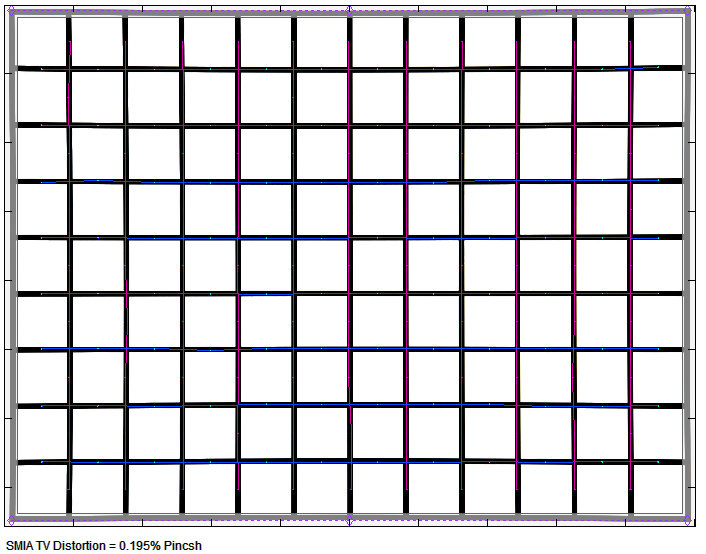
Vignetting
Auto-correction is also applied to the vignetting characteristic. The systems shows a very mild light falloff at 40mm and 100mm. At 150mm f/2.8 it’s a bit more noticeable at 0.6EV (f-stops) but normally you don’t need to care really. The issue is absolutely negligible from f/4 onward.
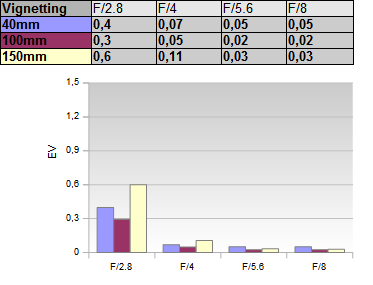
The RAW vignetting is slightly higher although most of this seem to relate to the uncorrected distortion actually. The RAW vs JPEG results aren’t completely comparable due to the different tone curves here. In any case, it’s not a hell of a difference.
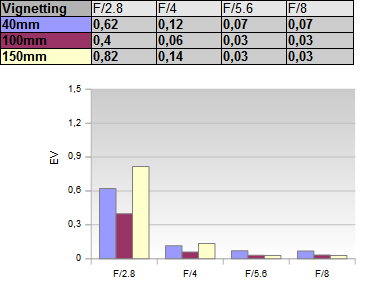
MTF (resolution)
The Olympus M.Zuiko ED 40-150mm f/2.8 Pro delivered impressive results in the MTF lab. At 40mm the center is pretty much excellent from f/2.8 onward. The borders/corners are good to very good. Diffraction has a higher impact from f/8 although f/11 remains usable. The 100mm setting is clearly the sweet spot. The center performance remains intact whereas the quality of the outer image region is boosted significantly. At medium apertures the borders are even reaching excellent levels which is rare for a zoom lens. Even the corners are easily very good at mainstream settings. 150mm sees a slight decrease across the image region but not by much.
The tested sample had an okay to good centering quality.
Please note that the MTF results are not directly comparable across the different systems!
Below is a simplified summary of the formal findings. The chart shows line widths per picture height (LW/PH) which can be taken as a measure for sharpness. If you want to know more about the MTF50 figures you may check out the corresponding Imatest Explanations

MTF (resolution) at 150mm with Olympus 1.4x Converter
To be honest with you – I was never overly fond of tele-converters. Tele-converters extend the reach, yes, but they also magnify the imperfections of the base lens – and zoom lenses have more than primes- and add their own thus they will always be a second grade choice. As a rule of thumb, a 1.4x converter costs about “one rating mark” thus also “two rating marks” for a 2x converter (which therefore rarely turns out good). Furthermore they increase the maximum aperture by their converter factor so they are pushing the resulting combination further into diffraction (smaller aperture). Consequently they work best with fast lenses. E.g. putting a 2x converter on a f/5.6 lens (effectively f/11) is not a good idea.
Now the Olympus M.Zuiko is reasonably fast (f/2.8) so the Olympus 1.4x converter translates this combination into a 56-210mm f/4 which is actually not a bad base. However, the penalty caused by the converter remains. This most obvious at maximum aperture (210mm) which is the point where the base lens is also the least “robust” (thus most vulnerable to centering imperfections). The result isn’t bad but the center is just good to very good followed by fair to good borders/corners. A perfectly centered lens (if it exists) will be somewhat better here. Stopping down boost the quality substantially towards a very good center and good/corners.
Consequently the combination had only an okay centering quality. We would certainly recommend to attach the converter only when needed.

Chromatic Aberrations (CAs)
Lateral CAs (color shadows at harsh contrast transitions) are just slightly visible with an average pixel width of around 1px at the image borders at the extreme ends of the range and a bit less in between. This is not disturbing.

Bokeh
The Micro-Four-Thirds system isn’t overly well suited to shallow depth-of-field photography. The small sensor and its 2x crop factor is limiting the potential here. As mentioned before the Olympus M.Zuiko Digital ED 40-150mm f/2.8 Pro “behaves” like a full format “80-300mm f/5.6”. Now that all being said it is, of course, possible to isolate your subject from the background although the difficult focus transition zone is comparatively deep so the smooth rendition of the bokeh is correspondingly difficult.
Unfortunately the Olympus lens has a clear weakness here – just like its Four-Thirds “predecessor” (Olympus Digital Zuiko ED 50-200mm f/2.8-3.5 SWD) actually. This is especially disappointing because the Olympus marketeers state otherwise. The first three sample crops below illustrate the degree of the bokeh roughness that you have to face.

The following sample crop is a bit of a torture test due to the harsh contrast but it clearly shows a so-called “Nisen” bokeh – thus sharply rendered out-of-focus stripes rather than graduated ones.

Out-of-focus highlights show an outlining effect as shown in the next image. Aspherical elements (the lens has a couple) are often the cause for this.

I’m sure many owners will be in disbelieve. However, please note that the above doesn’t mean that you can’t produce smooth backgrounds altogether – just see below. This simply requires a rather pronounced focus spread – thus the distance between main subject and background should be fairly big (dependent on the focus distance to your main subject). This is just about the sheer amount of blur though and not about the bokeh. Alternatively just avoid busy backgrounds.

Sample Images
The Olympus M.Zuiko ED 40-150mm f/2.8 PRO is, mostly, a highly desirable lens - except for one bug. On the positive side, it is very good if not excellent in the primary image quality metrics. It is very sharp across the focal length range including some greatness in the middle portion. Vignetting and distortions are very low - of course in the auto-corrected result but also in the underlying RAW image. The (uncorrected) lateral CAs are not an issue as well. One the downside, the quality of the bokeh (out-of-focus blur) can be disappointing - not in all scenes but busy backgrounds are clearly not the lens' best friends. The lens is also available in a kit with the Olympus 1.4x tele-converter. The combination is reasonably good but as so often with converters don't expect wonders.
The mechanical quality of the M.Zuiko is very impressive again. The lens body is made of all the right ingredients thus tightly assembled and sealed metal parts and smooth control rings. The awesome design of the telescope-style lens hood should also be mentioned here once more. The AF is speedy by Micro-Four-Thirds standards. The Olympus lens does NOT feature an image stabilizer. While this is not a problem on Olympus or Panasonic GX cameras, it is not be the best choice for the Panasonic GH, G and GM camera series.
Olympus M.Zuiko ED 40-150mm f/2.8 PRO is directly competing with Panasonic's Lumix G X 35-100mm f/2.8 Power OIS. Obviously the Olympus has the bigger range (and as such also a bigger size/weight) and is somewhat sharper whereas the Panasonic has clearly the better bokeh plus an image stabilizer. Both are very good really.
-
Optical Quality
-
Build Quality
-
Price / Performance

